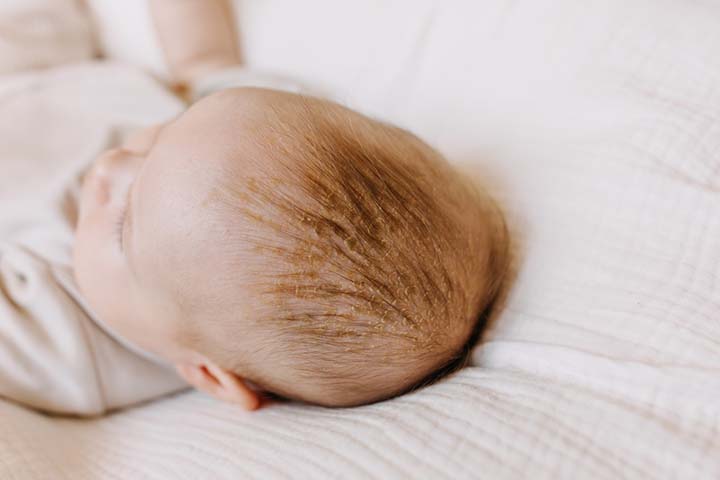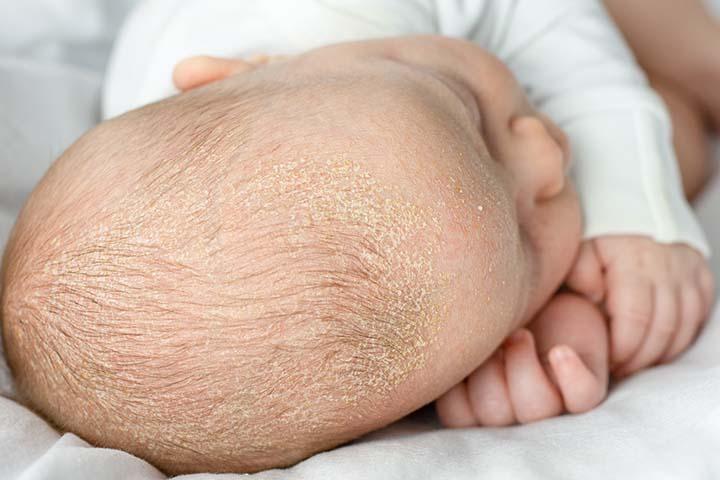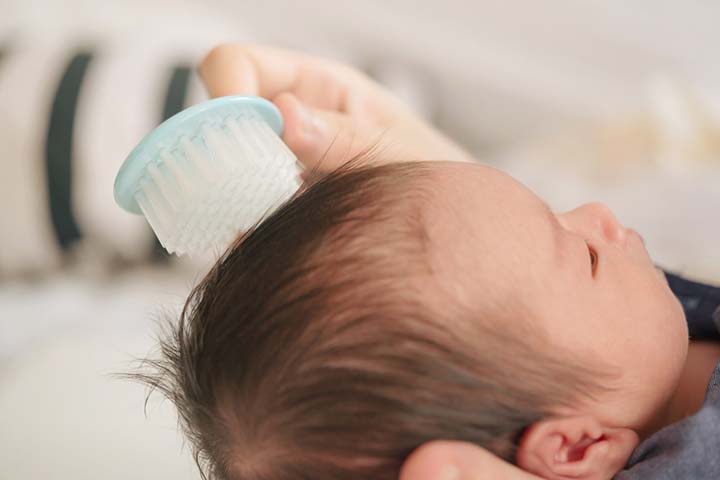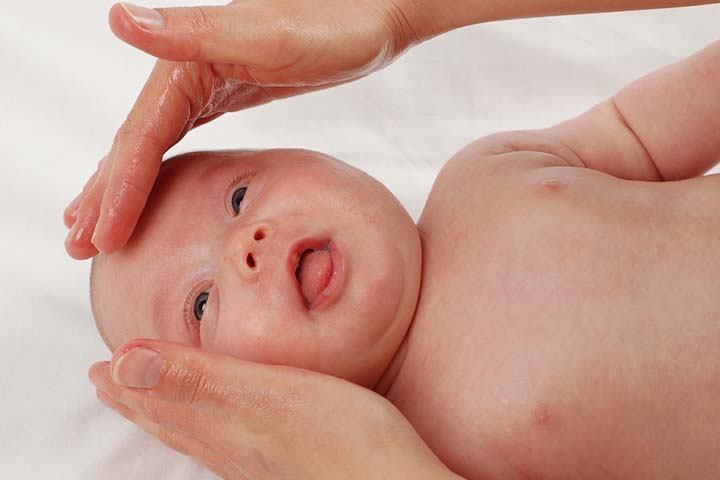Infantile seborrheic dermatitis (cradle cap) and baby dandruff are two types of the same disease affecting the seborrheic parts of the body. While seborrheic dermatitis is commonly seen on gland-rich regions of the scalp, face, and trunk, dandruff is restricted to the scalp (1) (2). Dandruff in babies is less common than in adults. Dandruff appears in babies for various reasons, including overgrowth of fungus, exposure to extreme heat, over-usage and under-usage of shampoo, sensitivity to hair products, and skin disorders. Read through this post to learn more about dandruff in babies, its signs, causes, management, preventive measures, and signs that may indicate a need to see the doctor.
Signs And Symptoms Of Baby Dandruff
There are several signs and symptoms that could indicate dandruff. However, common symptoms are (2) (3):
- Itchy or irritated scalp
- Flaky scalp, or dry skin without inflammation on baby’s scalp
- Red, yellow, or silvery patches on and around your baby’s head
- Scaling scalp that are rough to touch and may be seen as dry patches
Causes For Dandruff In Babies
The exact cause of dandruff is unknown. However, it is believed that it is a result of multiple factors like genetics, the yeast that naturally lives on the skin, irritants, chemicals, dry and cold weather, and overproduction of sebum (1). Out of the many, the most prevalent causes are:
- Cradle cap, which also causes scaly and flaky patches, mostly yellowish in appearance.
- Frequent shampooing, rendering the scalp dry due to moisture loss.
- Dry weather conditions such as winters can cause skin dryness, which may also affect the scalp.
The main causes of dandruff in babies include overproduction of sebum or skin oil, or overgrowth of a fungus called Malassezia, which may cause the skin cells on the scalp to shed quickly. In this case, you may notice gray or white flakes on your baby’s head (4).
When To See A Doctor?
Generally, with the use of some home remedies, dandruff can be treated within a week or so. But in case you see that the dandruff is persistent and even worsening, taking pediatric consultation is wise. This is more prudent if your baby’s scalp is showing the following signs:
- Oozing
- Cracking
- Bleeding
Are The Scales On Baby’s Head Only Due To Dandruff?
Scales on the baby’s head or body may not be due to dandruff always. If the skin on your baby’s scalp is scaling and flaking, it may be due to reasons other than dandruff, such as:
- Sunburn on the scalp: This risk can be avoided by limiting your baby’s exposure to the sun or making them wear a hat.
- Using excess shampoo and not rinsing well during a wash: Dried shampoo residue on the scalp can show up as flakes and may resemble dandruff. This can be avoided by spending more time rinsing than lathering and using no more than a dime-size dollop of shampoo.
- Shampooing less often causes oils and skin cells to accumulate on the scalp, thereby giving the flaky structure and an oily scalp.
- Atopic dermatitis (eczema)iXAn inflammation of the skin accompanied by itchiness and dryness commonly triggered by an allergen or psoriasisiXAn autoimmune disease that causes inflammation and flaky patches on the skin may cause scaling by making the skin dry. At times, it may not be easy to differentiate between normal dandruff and eczema. In fact, the Centers for Disease Control and Prevention reports that approximately 10.4% of children aged zero to five years have eczema. Babies affected by eczema may exhibit symptoms similar to that of dandruff.
- The cold, dry winter air, which renders the baby’s scalp dry, may also cause flakes.
- Cradle cap is another cause in babies less than one-year-old (5).
- RingwormiXAn itchy, red, circular rash on the skin and nails caused by a fungus, caused by a fungus, may also be a reason for flaking and hair loss in babies.
- Lice causes scalp itching, scratching, scalp rash and flaking, though it is not very common in babies.
According to Dr. Bidisha Sarkar, “Picking or scratching a baby’s dandruff may damage their delicate skin and cause bleeding, scarring, or infection. This will worsen dandruff by irritating the scalp and stimulating the production of more oil and skin cells.”
It is important to rule out the cause for flaking to proceed with the right dandruff treatment for babies. Visit your doctor for assistance if you suspect that your little one has dandruff. Do not delay if the baby scratches a lot and has visible skin irritation like itchy scales, red areas, oozing in the scalp. This is crucial as the same may indicate an underlying medical condition, such as a fungal infection.
How To Get Rid Of Baby Dandruff?
Once it is confirmed that your baby has dandruff, follow these steps to get rid of it.
- Brush the baby’s dry hair to remove large and visible flakes of dandruff before shampooing.
- The use of mineral oil to help get rid of dandruff is anecdotal, yet, it could be tried for the baby post pediatric consultation. This is crucial as the same will help in loosening the flakes stuck to the scalp. To use the oil, gently massage the oil on your baby’s scalp before shampoo. Let the oil stay on the scalp for some time and then comb your baby’s hair. As you shampoo, ensure that all the oil gets removed as otherwise, it could lead to more issues.
- Use regular baby shampoo to wash the baby’s hair every day. Mild dandruff can be easily removed this way.
- For severe dandruff, use medicated dandruff shampoo recommended by a pediatrician. Use once or twice a week, depending on the severity of dandruff and doctor’s prescription. While shampooing, leave the shampoo on the scalp for a minimum of two minutes.
- When washing the baby’s hair, gently use fingers to massage the scalp and build a good lather. Rinse with water thoroughly. Do not use any conditioners.
- Pat-dry the baby’s head with a towel.
- If the baby is prone to dandruff, then you must maintain the normal pH of the scalp, and an oil-free scalp mostly addresses the problem.
- The doctor may prescribe antifungal scalp lotion or cream for the baby. The hydrocortisone creamsiXA class of corticosteroids medication used for skin conditions such as redness, itchiness, and rashes available over the counter might aid in relieving inflammation, redness, and itchiness. But their use must be under pediatric guidance, preferably for correct dosage and usage (6).
You can also try home remedies to treat milder forms of cradle caps in your little one. For instance, Alyssa Paxson, a mother and a blogger, says, “Coconut oil also helped with his (son) cradle cap. I’d simply rub it on his scalp a little bit before giving him a bath and just wash it off when I washed his hair. Slowly but surely his cradle cap went away (i).”
How To Prevent Dandruff In Babies?
- Once treated, dandruff can recur. Hence, it is wise to follow some preventive steps that could help you keep your baby’s dandruff at bay.
- Fix a regular shampoo routine. Under and over-shampooing, both could disturb the pH of your baby’s scalp. The number of times you shampoo your baby’s scalp depends on their condition. For example, in the case of a cradle cap, shampooing daily could help remove excess oil and loosen the flakes on your baby’s scalp. However, for all other causes of the dry scalp shampooing every other day might avoid excess dryness.
- Use medicated shampoo prescribed by a doctor. They would suggest a specific shampoo to your baby after determining the cause for dandruff.
- Regular oiling. This could help avoid the build-up of stuck-on dandruff flakes. While you use an oil, using an organic, virgin oil, such as coconut oil or olive oil, would be good.
Dandruff in babies may present as itchy, scaly scalp, or rough to touch dry patches. Factors such as weather conditions, baby products, or other irritants may be responsible for dandruff. An oiling and shampooing routine can help prevent recurrent episodes of dandruff. Consult a pediatrician if the condition is not resolved with home remedies or shows signs of cracking or bleeding. Severe forms may indicate underlying conditions, such as psoriasis, eczema, and cradle cap that may require treatment. Use anti-fungal or anti-inflammatory lotions or creams only upon doctor prescription.
Key Pointers
- Dandruff and infantile seborrheic dermatitis (cradle cap) affect seborrheic skin regions in babies.
- Typical symptoms of infant dandruff include an itchy scalp, flaky, dry skin without irritation, and areas of red, yellow, or silvery skin.
- The cause of babies’ dandruff is often ambiguous and may be brought on by heredity, yeast, allergens, chemicals, dry weather, or an excess of oil on the scalp.
- If dandruff continues and worsens, particularly if the baby’s scalp exhibits bleeding, seeping, or splitting symptoms, a pediatrician should be consulted.
- To get rid of baby dandruff, brush the baby’s dry hair to remove large flakes, use mineral oil or baby oil on the scalp, shampoo with a gentle and moisturizing shampoo, and avoid overuse or underuse of shampoo.
Are you worried about a cradle cap on your baby’s scalp? Learn valuable tips from this video on treating cradle caps, ensuring your baby’s scalp remains healthy and flake-free.
10. Cradle Cap (Seborrheic Dermatitis in Infants); Cleveland Clinic
11. Can A Child Have Psoriasis; American Academy of Dermatology Association.















